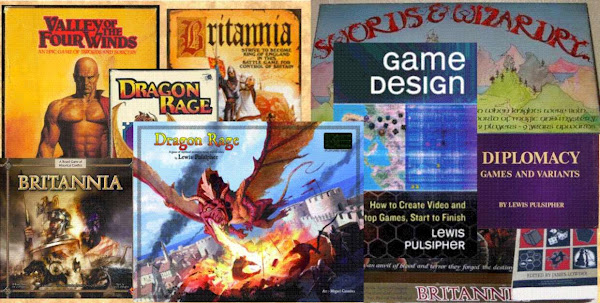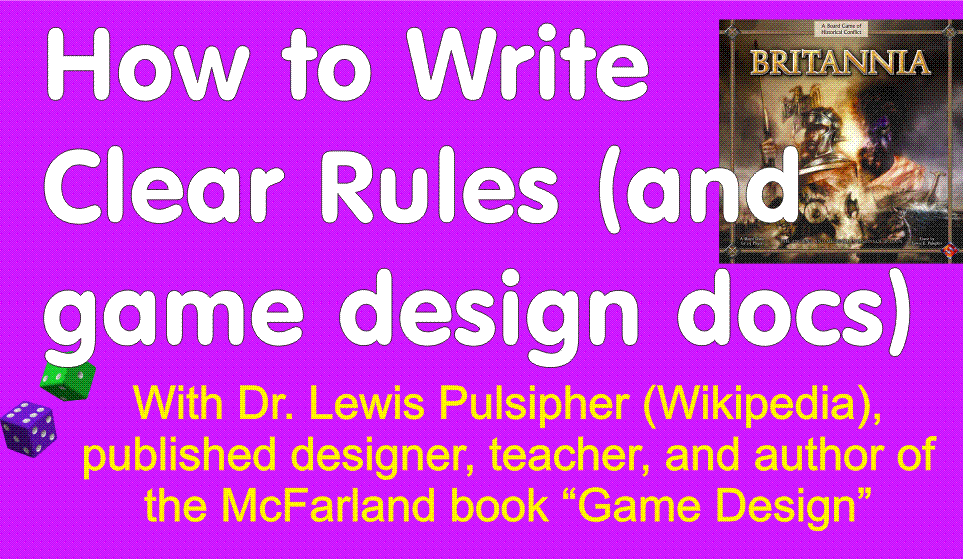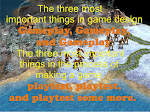As some of you know, I recently signed a contract with McFarland & Co, Publishers, for a book about learning to design (video) games. I have just finished the "next-to-final" draft, which is being commented on by some people, and will need to submit the final draft by Oct 15. With luck it will be available next year. (Keep in mind how long these things can take.)
The title I favor is "Learning Game Design", because I have not tried to be comprehensive. In fact, I've cut out almost as much as there is in the book (102,000 words at this point).
While it is about learning video game design, it also covers tabletop design to a great extent, both because they are the same in most respects, and because the best way to learn video game design is to start with the tabletop, as I explain at length in the book.
Lew
Tuesday, August 30, 2011
Sunday, August 28, 2011
The Interface
All games have an interface, whether it’s pressing a button or moving a joystick, or manipulating cards and pieces. A poor interface can ruin a game; if you’ve played many video games you’ve surely been frustrated when the game made it hard for you to tell it what you wanted to do, a failure of the interface. We’d all like to just think what we want the game to do, and have it act accordingly, but that remains an aim for the Matrix/Star Trek holodeck future.
For a AAA game there might be a designer or two who only work on the game interface. People who are learning to design games cannot devote all their time to interface but it is still important topic.
Jakob Nielsen is the guru of usability for commercial Web sites, and has been for many, many years. (His partner is Don Norman, who wrote "The Design of Everyday Things", a classic book which I recommend you read.) Much of what Nielsen writes about making easy-to-use Web sites also applies very closely to designing good games. Every few weeks he publishes a new article. I strongly recommend that anyone who wants to be a good game designer read his material. You can begin with http://www.useit.com/alertbox/design-diversity-process.html
Nielsen identifies ten general principles--rules of thumb--for Web user interface design. I'll try to summarize these in relation to games.
"Visibility of system status". Users should be able to look at the game and know what's going on (as far as they ought to know, of course–information about the opposition may be hidden). When they do something they should be able to see the result, usually immediately.
"Match between system and the real world". The game should use words, phrases, and concepts easily understood by the user. We know that you shouldn't ask five-year-olds to do complex math or understand "big words". But every target audience has its characteristics that the game needs to accommodate. Furthermore, information should be presented in a logical order.
"User control and freedom". Give users a way to bail out when they make a mistake in using interface--not a game mistake but a game manipulation mistake. Allow undo and redo in video games.
"Consistency and standards". Follow platform conventions. People expect things to work a certain way, and if you do it another way that may interfere with their enjoyment of the game. This is one place where doing it the standard way is almost always a good thing.
"Error prevention". Design games so that users are unlikely to make mistakes. Good error messages are important but design that avoids mistakes is better.
"Recognition rather than recall". Don't make the user memorize things or keep track of things, let the game do it. Instructions should be easy to find if they're not visible.
"Flexibility and efficiency of use". Allow expert users to install shortcuts, such as remapping keys and joysticks on a controller. Don't expect the new user to use obscure commands.
"Aesthetic and minimalist design". Don't provide irrelevant information. Don't require two actions where one action will do.
"Help users recognize, diagnose, and recover from errors". When a user does something wrong, describe exactly what the problem is and suggest a solution
"Help and documentation". The ideal game does not require the user to learn any rules, but this is rarely practical. Help and documentation (such as rules for tabletop games) should be easy to search.
See http://www.useit.com/papers/heuristic/heuristic_list.html.
Wednesday, August 24, 2011
A really big playtest failure
"Playtesting is sovereign", I like to say to students. But it has taken a long time for videogame companies to recognize this, and there're still examples of complete failures to do playtesting right even when they play test.
An example from last year is Final Fantasy XIV. Final Fantasy games are normally praised but this one has been trashed by reviewers. It's score on Metacritic (an aggregator of reviews) is 49, which is really bad for a videogame. http://www.metacritic.com/game/pc/final-fantasy-xiv-online/critic-reviews
Here are some excerpts:
"It may be hard to believe, and painful to accept, but the last 'official' chapter of Final Fantasy is a huge disappointment, and it not only becomes the worst chapter of the saga, but also one of the worst MMORPG we have played in a long time. It's obvious that Square-Enix is no longer what it used to be."
"Final Fantasy XIV is in no way, shape, or form ready for commercial release. We suppose there is potential down the line for the experience to improve with patches and tweaks, but that doesn't justify why the game is in such shambles at launch. "
GameSpy (gave a 40). "Extended stretches of confused incredulity, punctuated now and then by bursts of intense anger. And yeah -- I just equated FF XIV with a filthy bathroom."
PC Gamer (gave a 30). "A shallow, slow, grind-heavy MMO crippled by a horrible interface and nonsensical player limitations."
So didn't they playtest it? Yes, they did! I found evidence of an open beta: (http://www.ffxivvault.com/ffxiv-beta-information.php and http://www.wired.com/gamelife/2009/12/final-fantasy-xiv-beta-test-now-recruiting/). "Anyone that wishes to be among the first to play the new MMORPG, which will launch on PlayStation 3 and PC in 2010, can sign up at the official beta site. Square Enix says that no prior MMO experience is required, and players selected to be in the beta will test the Windows version of the game."
So what happened? Did they test only with fanboys and girls? Did they ignore the results? It seems unlikely that they ran out of time and put the game out before was ready, because Square Enix is one of the more respected and consistently good videogame publishers.
So what can happen to give a "false positive" from playtesting?
First, you could be playtesting with people who know the game so well that the problems just don't register. But this would be likely only if the people within the studio were the playtesters, and in this case it was an open beta.
Second, you can have open playtesting but somehow you only get fanboys and fangirls, people who will say good things about your product no matter what. The have lost their critical faculties where you are concerned. Perhaps this is what actually happened. This is why you want to try to get many playtesters who don't know your products and you aren't prone to this kind of thing.
Third, you could just ignore the results, saying "oh well we know it's good". I'm convinced that Microsoft has done this quite frequently, adding smugly "we know what's best". There can be many examples but in the video game category the most famous one is the huge controller that Microsoft included with the original Xbox. Apparently it was sized for people my height (2 meters) with correspondingly large hands. According to what I've read Microsoft continued to maintain that it was fine but finally changed to a much more normal sized controller.
Fourth, perhaps they asked the wrong questions and yet didn't pay attention to the actual play. Frequently if you ask people what they think you'll get a different story than if you simply watch them and listen to them without interfering. Jakob Nielsen, the guru of web usability, always cautions you to watch people, not asked them what they will do or what they have done, because you get better data.
Monday, August 22, 2011
How long it takes
Gamers are often surprised at how long it takes for games to be published. Mayfair recently published a game that one of the principles thought they had had for eight years. Once I decided to revise the Britannia took three years to revise it and get it published. The Dragon Rage reissue took a similar time, though much of that was because it was a startup publisher. I have a game with Mayfair now that they originally saw it PrezCon 2008, if I recall correctly.
The book publishing industry can be slow too. My contribution called "The Three Player Problem" leads off the ETC Press book Tabletop Analog Game Design. This book was released this month. Because of the way ETC Press does things, giving unformatted electronic copies of books away and selling formatted publish on-demand versions for those who want paper copies, you'd think their process would be faster than a typical publisher that needs to print several thousand copies of a book. But this book has many contributors, and most of them did not write that contribution as soon as they were asked, the way I did. So I wrote my 5,000 words and "finished" the submittal copy on 13 September 2009. This was posted on a wiki for comments. I made slight changes by March 2010. The book was published in August 2011, nearly two years after I wrote the article.
When you read Writer's Market you see that publishers often say they'll take 15 to 18 months or more to publish a book once they've received the manuscript. I suppose much of this time must be in editing, because there's no typesetting involved anymore. All I know for sure is that but publishing takes a long time just as game publishing takes a long time.
Monday, August 15, 2011
Simple Versus Complex As a Game Design Philosophy
At conventions this summer I’ve watched two multiplayer fantasy wargames with many similarities but perhaps different philosophies of design. At the UK Game Expo in Birmingham England I watched Wizards of the Coast’s new game Dungeons and Dragons Conquest of Nerath being played, and at WBC in Lancaster Pennsylvania I watched a not yet published (P500) game called War Party.
Both games can accommodate up to four players, but by dividing them into two sides, that is there were not four independent sides but two partnerships, rather like Axis and Allies when you play with four or five people. (You can play four sides, but the games aren’t designed to optimize that situation.) If you play with three then one player controls two of the four nations/kingdoms. One nation is in each of the four corners.
There seem to be two points of view about game design expressed in current games. The short expression of my view is “KISS” or “keep it simple Simon”. The longer expression of this is my favorite quote related to games, which I put at the bottom of the page for my blogs and my website: "A designer knows he has achieved perfection not when there is nothing left to add, but when there is nothing left to take away." (Antoine de Saint-Exup'ery).
The opposite view, which seems to be more and more commonly expressed in Eurostyle games these days, is that complexity is good, pretty much for its own sake. It’s as though adding features is a good thing, even though virtually every game can be reduced to a simple essence. (See http://pulsiphergamedesign.blogspot.com/2011/04/essence-of-game.html). Especially in abstract games, which includes many Euro games despite the atmosphere that’s tacked on, I think simpler is better so that players can concentrate on strategy rather than on details.
These two games, essentially about the same topic and approached in the same way, can be used to represent the two different views, although Nerath isn’t as simple as it *could* be. There is much more unit differentiation in War Party than in Nerath. In the latter game the units of each nation are often functionally the same as units of other nations. There are no separate, individual heroes who are not military units like all the other units. In War Party there is more differentiation, but there are also individual heroes that can be customized in a variety of ways. A couple of the military units in Nerath are allowed to go into the dungeons and “explore” while in War Party it is presumably the individual heroes who go. There appeared to be a lot more pieces on the board in WP, as well. Both are games about war rather than about battle, that is, economy plays a big part in success or failure.
Nerath uses Event Cards. Is this a complication? Event Cards are a case of adding variety (and replayability) without adding much rules complexity, because the rules are on the cards, and only need to be considered one by one as you draw the Events.
Nerath uses a victory point method, mostly related to capturing territories, that should see the game ended in about 90-120 minutes. I watched enough games to believe that. I was told War Party was upwards of 3 hours.
There are many other differences. For example, Nerath uses very nice plastic figures, while War Party uses large cardboard counters. Nerath has set-in-stone starting positions that mix the four nations closely together, as well as a standard playing order, both simplifying the game. I can see people developing standard first turn movement deriving from the standard set up, but that doesn’t make the play complicated, it just gives players something to think about when they’re not playing the game. In War Party each nation starts at the corner the board and spends a couple turns expanding without much contact with the other nations. Nerath also includes seas and ships that are absent from War Party.
And I would expect that Nerath plays faster because you don’t have that slow period of expansion without strong competition. The war is on immediately thanks to the way the nations are mixed together and yet sometimes have one part separated from another part of the same nation.
Nerath is not nearly as simple as, say, Diplomacy or Risk, but it is much more colorful than either. “Colorful” comes from the cards, from the intertwined nations, and from the pieces. By comparison War Party looks drab, but not having watched it nearly as much as I watched Nerath, I might not have seen the “color” beneath the surface.
One reason to play this kind of fantasy game is the color. If people are primarily interested in your game because of the topic, rather than because of the gameplay, then you can get too simple. You can remove so much of the color, the flavor of the topic, that potential players are no longer interested in the game.
I’ve not played either of these games, nor have I talked with anyone who’s played a lot (that is, who wasn’t involved in the development of the game), so I can’t tell you which game plays “better”, if any. I’d prefer to play Nerath because it’s a shorter game and the concept doesn’t deserve a longer game, and because the strategy looks much more interesting (I like the mix of sea and land). But I am sure there are people who would prefer the more complex game in terms of rules and variety, even though I suspect it is less interesting in terms of strategy.
Tuesday, August 09, 2011
WBC, Dragon Rage, and Tabletop game design book
I was at WBC in Lancaster PA for three days recently. My Thursday night talk about game design had a pretty good attendance, perhaps slightly less than when it is on the weekend (I couldn't be there at the weekend this year).
A review of Dragon Rage appeared in a British blog:
http://rivcoach.wordpress.com/2011/08/08/review-dragon-rage-from-flatlined-games/
Also on BGG:
http://boardgamegeek.com/thread/684165/boardgames-in-blighty-reviews-dragon-rage
The multi-contributor ETC Press book "Tabletop: Analog Game Design," edited by Greg Costikyan and Drew Davidson, is now available (electronic downloads free). Greg briefly describes it at:
http://www.gamasutra.com/blogs/GregCostikyan/20110808/8151/Tabletop_Analog_Game_Design.php (you can click on the title of this post for this one)
Downloads in electronic book and PDF formats at:
http://www.feedbooks.com/userbook/22317/tabletop-analog-game-design
My piece on "The Three Player Problem" is the first chapter in the book.
A review of Dragon Rage appeared in a British blog:
http://rivcoach.wordpress.com/2011/08/08/review-dragon-rage-from-flatlined-games/
Also on BGG:
http://boardgamegeek.com/thread/684165/boardgames-in-blighty-reviews-dragon-rage
The multi-contributor ETC Press book "Tabletop: Analog Game Design," edited by Greg Costikyan and Drew Davidson, is now available (electronic downloads free). Greg briefly describes it at:
http://www.gamasutra.com/blogs/GregCostikyan/20110808/8151/Tabletop_Analog_Game_Design.php (you can click on the title of this post for this one)
Downloads in electronic book and PDF formats at:
http://www.feedbooks.com/userbook/22317/tabletop-analog-game-design
My piece on "The Three Player Problem" is the first chapter in the book.
Subscribe to:
Posts (Atom)










